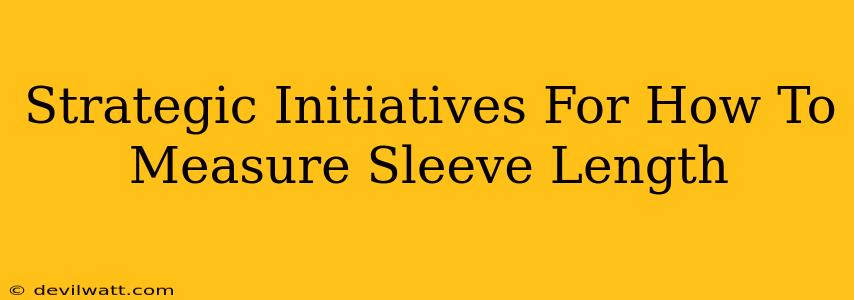Getting the perfect sleeve length is crucial whether you're sewing a custom garment, altering an existing one, or even just buying clothes online. A poorly measured sleeve can throw off the entire look and feel of your outfit. This guide outlines strategic initiatives to ensure accurate sleeve length measurement every time.
Understanding the Nuances of Sleeve Measurement
Before diving into the how-to, let's address some crucial points impacting accurate sleeve length measurement.
Different Sleeve Styles, Different Measurements:
Not all sleeves are created equal! The measurement process varies depending on the sleeve style. Consider these key types:
- Set-in Sleeves: These are classic sleeves sewn into the armhole. Measurement starts from the shoulder seam.
- Raglan Sleeves: These extend from the neck to the cuff in a diagonal line. Measurement is typically taken from the neck point to the cuff.
- Kimono Sleeves: These are cut as one piece with the bodice. Measurement is less straightforward and often involves multiple points.
- Dolman Sleeves: These are loose fitting and often bat-winged. Measurement needs to account for the unique drape and shaping of this style.
Ignoring these variations will lead to inaccurate measurements. You need a tailored approach based on your specific sleeve style.
Body Variations & Personal Preferences:
Even with the same sleeve style, individual body variations will impact the ideal sleeve length. Consider these factors:
- Arm Length: Obviously, longer arms require longer sleeves!
- Shoulder Width: This influences how the sleeve sits and its perceived length.
- Desired Fit: Do you prefer a sleeve that falls at the wrist, just above, or slightly below? Your personal preference will dictate the final measurement.
A one-size-fits-all approach won't cut it. Tailor your method to your body and preferred style.
Strategic Steps for Accurate Sleeve Length Measurement
Now for the practical part! Here's a step-by-step guide for measuring sleeve length, adaptable to different sleeve styles.
Gathering Your Tools:
You'll need:
- Flexible Tape Measure: A rigid tape measure won't conform to the body's curves accurately.
- A Friend (Optional but Helpful): Having someone assist with measuring will provide a more precise reading.
- Garment (For Alterations): If altering an existing garment, use it as your reference point.
Step-by-Step Measurement Process:
- Identify the Starting Point: This depends on the sleeve style (see above). For set-in sleeves, it’s the shoulder seam.
- Maintain Proper Posture: Stand tall with relaxed shoulders. Poor posture can skew the measurement.
- Accurate Placement: Ensure the tape measure lies flat against the skin, following the natural curve of the arm.
- Measure to the Desired Point: Measure to your preferred sleeve length – wrist, elbow, etc. Again, consider your sleeve style and desired fit.
- Record Measurement: Write down the measurement in inches or centimeters. Double-check for accuracy.
Remember to account for seam allowances when cutting fabric. Your measurement should include extra fabric for seams.
Optimizing Your Measurement Strategy
To truly master sleeve length measurement, consider these advanced techniques:
Using a Sample Garment:
If you're sewing a new garment, use a well-fitting shirt or top as a template. Measure the sleeve length on this garment to get a starting point.
Trial and Error (with Fabric Scraps):
Cut out small fabric scraps to test sleeve lengths before committing to the final cut.
Conclusion
Measuring sleeve length might seem simple, but mastering the nuances can significantly enhance your sewing projects and clothing purchases. By understanding the different sleeve styles, considering individual body variations, and following the strategic steps outlined above, you can achieve consistently accurate measurements and a perfect fit every time.

